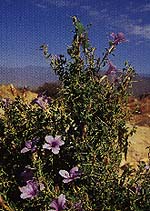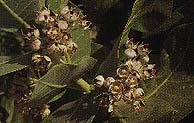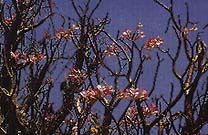Text and pictures by Graham R. Lobely
Contrary to its usually perceived image as a fairly barren desert Kingdom, the south-western lowlands and mountains of Saudi Arabia have an wide variety of flora and fauna. Beautiful flowering plants can be seen and enjoyed, particularly following good winter rains. Flowers are a key component of the food chain, providing food for many insects as well as certain birds, such as the gorgeous nectar-drinking sunbirds.
 The lowland Tihama is drier and relatively poorer in vegetation compared to the Sarawat mountains, which typically rise to an escarpment rim elevation of 2500 m. These impressive mountains run parallel to the Red Sea and the west-facing escarpment is situated approximately 50-100 km from the coast, from which it is separated by the lowland plains and hills of the coastal Tihama.
The lowland Tihama is drier and relatively poorer in vegetation compared to the Sarawat mountains, which typically rise to an escarpment rim elevation of 2500 m. These impressive mountains run parallel to the Red Sea and the west-facing escarpment is situated approximately 50-100 km from the coast, from which it is separated by the lowland plains and hills of the coastal Tihama.
Most of the Tihama flowers are found on drought-resistant woody shrubs and small trees. Many of these woody plants have quite small and waxy leaves and relatively tiny flowers, both intended to minimize the dessication effects of strong sunlight. Beautiful flower displays can be seen when there has been enough rainfall over the winter months.
To discourage grazing animals from browsing their foliage, the surviving dominant plants have developed two principal types of defence - physical and chemical. Physical defence is typified by the lethal-looking thorns of the acacia family of trees. Nonetheless, camels can often be seen grazing acacias, with apparent impunity. Chemical defence against grazing occurs in those plants that contain substances which are toxic to animals. The milkweed shrub (Calotropis procera)and the bottle tree (Adenium obesum)are two good examples. The milkweed is common throughout the region and is so-named as its leaves ooze a milky sap when cut.
 The spectacular bottle-tree is found especially in the southern foothills of the Tihama. Classed as a succulent, these plants are unmistakable from their enormous trunks. The bottle-tree reaches a height of up to 4 m with a bulbous trunk measuring approximately a metre in diameter. The single pink flowers produce a lovely delicate display and form a favoured food source for nectar-drinking Shining and Nile Valley Sunbirds.
The spectacular bottle-tree is found especially in the southern foothills of the Tihama. Classed as a succulent, these plants are unmistakable from their enormous trunks. The bottle-tree reaches a height of up to 4 m with a bulbous trunk measuring approximately a metre in diameter. The single pink flowers produce a lovely delicate display and form a favoured food source for nectar-drinking Shining and Nile Valley Sunbirds.
The most attractive flowers in the Tihama are found on the Delonix elata tree. These trees are often located on boulder outcrops, where more water can be trapped. Their gorgeous creamy flowers turn yellow with age and have a long flowering period in the spring months January-April. In years of lower rainfall the trees do not flower.
Abutilon muticus is a widespread shrub which has lovely apricot-yellow flowers with deep crimson centres. These open from the late afternoon into the evening, thus minimising water-loss and providing valuable nectar for nocturnal moths.
Carulluma russeliana , a succulent with unusual looking deep purple flowers, occurs in the Tihama foothills close to the escarpment. Some euphorbia species are spiny succulents, which are very similar in appearance to the cacti of the Americas. Euphorbia have a white latex-type sap, which can be very poisonous and is also capable of causing temporary blindness. Large euphorbia are often found in the wadis and foothills of the southern Tihama.
Moving up into the mountains, herbaceous flowering plants can be found, which are closely related to more temperate species. Geranium ocellatum has beautiful magenta flowers, usually found in late January and into February. The plant occurs on the escarpment slope and close to the rim in damper, rocky clefts which are kept moist by the fairly regular rainfall on the escarpment. Voracious herds of goats have overgrazed many areas, so the herbaceous wild flowers are now often restricted to less accessible locations.
 Beautiful asphodels, such as Asphodelus aestivus, can be locally abundant close to the escarpment rim. The terraced fields characteristic of these mountains are rewarding places to look for these striking plants, which are members of the lily family.
Beautiful asphodels, such as Asphodelus aestivus, can be locally abundant close to the escarpment rim. The terraced fields characteristic of these mountains are rewarding places to look for these striking plants, which are members of the lily family.
Pterocephalus pulverulentus is another attractive herb, related to the scabious which flourishes in the mountains within the open woodlands of juniper trees. The bladder dock(Rumex versicarius) is a small herb with attractive red flowers which can often be seen in roadside cuttings. Bedouin eat its leaves in salads.
As in the Tihama, woody shrubs are also widespread in the mountains. Euryops arabiscus is a lovely yellow-flowered shrublet which has an extended flowering period covering most of the year. There are also attractive purple lavenders, such as Lavandula dentata, which produce luxuriant flower displays in spring time. In May, Rosa abyssinica can produce an attractive splash of white flowers along the edges of terraced fields.
Web Links | Subjects | Search
Arabian Wildlife. Volume 2, Number 3